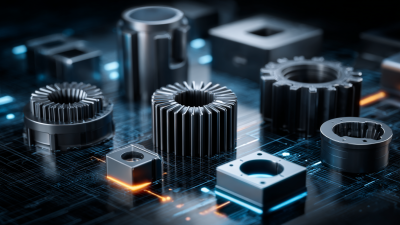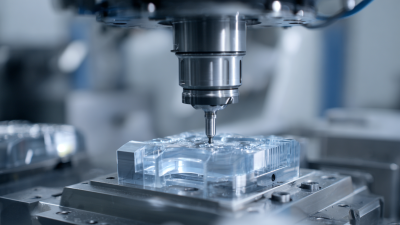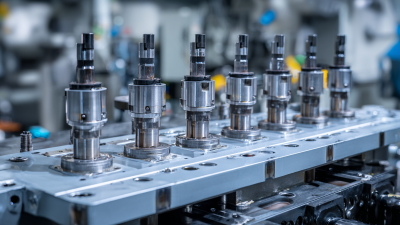
Exploring Innovative Alternatives to Mold Plastic Injection in Modern Manufacturing: Trends and Insights
In recent years, the manufacturing industry has experienced a significant shift towards more innovative alternatives to traditional mold plastic injection techniques. As highlighted in a report by Smithers Pira, the global market for injection molding is projected to reach $326 billion by 2024, indicating the immense reliance on, and growth of, this established method. However, the increasing demand for sustainable practices and advanced technologies has prompted manufacturers to explore new avenues, such as 3D printing and bio-based materials, which not only reduce environmental impact but also enhance production efficiency. According to a study by Research and Markets, the adoption of additive manufacturing technologies is expected to grow at a CAGR of 20% from 2021 to 2026. This blog will delve into the latest trends and insights into these innovative alternatives, challenging the conventional mold plastic injection processes and paving the way for a more sustainable and efficient future in manufacturing.

Innovative Materials: A Shift from Traditional Plastics in Manufacturing Processes
As industries evolve, there is a pronounced shift toward innovative materials that challenge the long-standing dominance of traditional plastics in manufacturing processes. The environmental implications of plastic waste, coupled with rising consumer demand for sustainable products, have catalyzed this change. Modern manufacturers are now exploring bio-based alternatives, such as biopolymers made from renewable sources like cornstarch and sugarcane. These materials provide comparable performance while reducing the carbon footprint, thus aligning with eco-friendly commitments.

Additionally, advancements in material science have introduced composites that blend natural fibers with polymers, resulting in lightweight yet strong products. These innovative alternatives not only enhance product durability but also offer customization options that cater to various industries, from automotive to consumer goods. The integration of such materials into the manufacturing workflow signifies a pivotal movement towards sustainability, enabling businesses to meet regulatory expectations while appealing to environmentally conscious consumers. This transformation reflects a broader trend where innovation meets responsibility, reshaping the future of manufacturing.
Additive Manufacturing: Transforming Production with 3D Printing Technologies
Additive manufacturing, particularly through 3D printing technologies, has been transforming production processes across various industries. According to a report by Mordor Intelligence, the global 3D printing market is projected to reach approximately $41 billion by 2026, growing at a CAGR of around 26%. This rapid expansion is attributed to the technology’s ability to reduce lead times, minimize waste, and enable the production of complex geometries that traditional manufacturing methods, like injection molding, often struggle to achieve.

One of the key advantages of additive manufacturing lies in its versatility, offering solutions for both prototyping and full-scale production. A study from Deloitte indicates that 3D printing can reduce product development costs by up to 75%, allowing companies to iterate designs quickly without the burden of extensive tooling. Businesses are increasingly employing this technology not only to enhance their product offerings but also to streamline supply chains by producing components on-demand, closer to the point of use. With benefits like these, it is no surprise that companies are embracing additive manufacturing as a vital component of their modern manufacturing strategies.
Sustainability in Manufacturing: The Rise of Bio-based and Recycled Alternatives
In recent years, the manufacturing sector has witnessed a significant shift towards sustainability, spurring the rise of bio-based and recycled alternatives to traditional plastic injection molding. According to a 2021 report by MarketsandMarkets, the global bio-based plastics market is projected to reach $18.5 billion by 2024, growing at a CAGR of 25.3%. This growth is primarily driven by increasing consumer awareness of environmental issues and the need for sustainable production practices. Materials derived from renewable resources, such as polylactic acid (PLA) and polyhydroxyalkanoates (PHA), have gained traction as they offer comparable performance to conventional plastics while reducing carbon footprints.
Recycling technologies have also evolved, leading to an increase in the adoption of recycled plastics in manufacturing processes. A recent study by the Ellen MacArthur Foundation revealed that incorporating recycled plastics could potentially reduce greenhouse gas emissions by 70% compared to virgin plastic production. Moreover, the European Union’s circular economy action plan emphasizes the importance of recycling and the use of secondary raw materials, aiming for 10 million tons of recycled plastics to be used in new products by 2025. This shift not only helps in reducing waste but also promotes the economic viability of sustainable manufacturing practices, encouraging companies to transition towards a more circular economy.
Exploring Innovative Alternatives to Mold Plastic Injection in Modern Manufacturing: Trends and Insights
| Alternative Material | Source | Main Benefits | Challenges | Adoption Rate (%) |
|---|---|---|---|---|
| PLA (Polylactic Acid) | Corn Starch | Biodegradable, Low carbon footprint | Lower thermal resistance | 15% |
| rPET (Recycled Polyethylene Terephthalate) | Recycled Plastics | Reduces landfill waste, Energy efficient | Potential impurities | 25% |
| Natural Fiber Composites | Plant Fibers (e.g., hemp, flax) | Lightweight, Good mechanical properties | Moisture absorption | 10% |
| Bio-based Polyethylene | Sugarcane | Renewable resource, Reduces carbon emissions | Higher production costs | 20% |
| Polyhydroxyalkanoates (PHA) | Bacterial fermentation | Biodegradable, Versatile processing | Expensive to produce | 5% |
Smart Manufacturing: Integrating AI and IoT for Enhanced Production Efficiency
The integration of Artificial Intelligence (AI) and the Internet of Things (IoT) has revolutionized modern manufacturing, making processes smarter and more efficient. According to a report by McKinsey, AI can enhance productivity in manufacturing by up to 20%. By leveraging machine learning algorithms, manufacturers can predict maintenance needs in real-time, minimizing downtime and prolonging equipment life. This predictive maintenance capability, powered by IoT sensors, allows companies to act swiftly before an issue escalates, translating to significant cost savings.

Moreover, a study from Deloitte revealed that manufacturers implementing IoT technologies could see a potential increase in profitability of up to 27% over five years. IoT devices collect vast amounts of data, enabling manufacturers to optimize their supply chains and reduce waste. Smart factories equipped with interconnected devices and AI analytics can streamline production lines, adjust to fluctuations in demand instantaneously, and improve the overall quality of products by identifying defects early in the production process. These innovations are not just enhancing efficiency; they are reshaping the entire landscape of manufacturing, driving companies toward a more sustainable and competitive future.
Cost-Benefit Analysis: Evaluating Alternatives to Plastic Injection Molding in Modern Industry
The manufacturing landscape is evolving, as industries seek innovative alternatives to traditional plastic injection molding. A recent report by the American Society for Quality indicates that injection molding accounts for over 30% of the plastic fabrication market. However, with increasing material costs and environmental scrutiny, companies are exploring other methods. Processes such as additive manufacturing and thermoforming are gaining traction, with a 25% growth expected in the 3D printing sector by 2026, according to Wohlers Associates.
Cost-benefit analyses show that alternatives can lead to significant savings. For example, additive manufacturing can reduce material waste by up to 90%, meaning that businesses can not only save on raw materials but also lower disposal costs. Additionally, the upfront investment in 3D printing technology can be recouped within two years due to the reduced labor and production time.
Tip: When evaluating alternatives to plastic injection molding, consider the long-term sustainability of the materials used. Recycling rates for certain materials can significantly influence the overall cost savings over time. Always factor in maintenance costs and required training for new technologies to ensure a comprehensive financial analysis.
Related Posts
-

Exploring the Benefits and Applications of Various Injection Molding Products in Today's Industry
-

Mastering Injection Mold Fabrication: A Step-by-Step Guide for Beginners
-

Creative Examples of Successful Injection Molding Applications Across Industries
-

Quality Driven Global Success of Prototype Injection Molding from China
-

5 Key Benefits of Investing in Injection Tooling for Global Buyers
-

Common Challenges Faced in Mold Plastic Injection Processes
